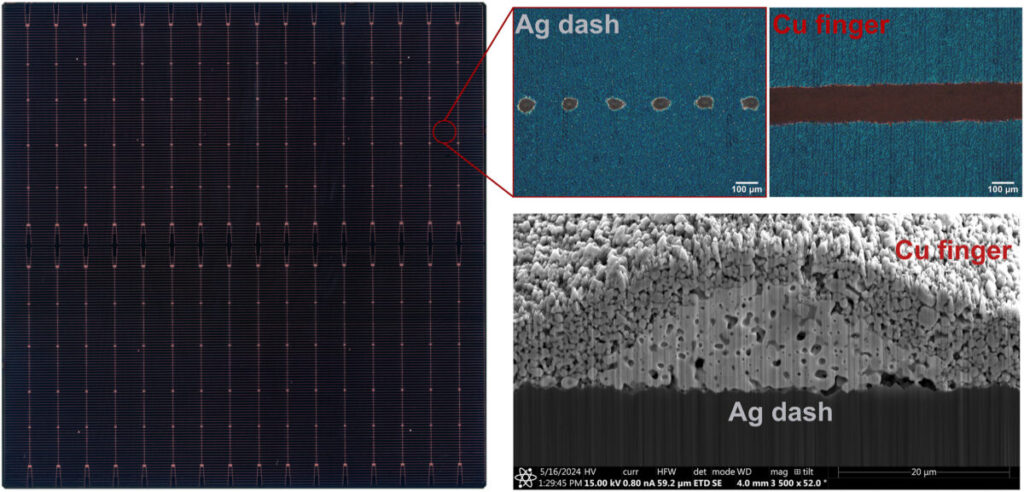An international research team has developed a metallization technique for topcon sun cells that are reportedly reduced silver use in the back of the devices by 85%. The scientists replace the generally used AG fingers with intermittent AG stripes for contact formation and AG-free fingers and bus bars for electrical conduction.
Researchers from the University of New South Wales (UNSW) in Australia and the Chinese metallization pasta specialist Changzhou Fusion new materials claim to have developed a silver-lan screen printing metallization technology that can significantly reduce the silver (AG) consumption in topcon sun cells without the efficiency and performance and performance of the performance and performance of the performance and performance and performance of the performance and performance and performance of the performance and performance and performance of the device and performance and performance and performance and performance and performance and performance and performance and performance and performance and performance and performance and performance and performance and performance and performance and performance and performance and performance and performance of the device and performance and performance and performance and performance and performance and performance and performance and performance and performance and performance and performance and performance of the
With the proposed technology, the scientists replace the generally used AG fingers by intermittent AG stripes for contact formation and AG-free fingers and buses for electrical conductivity.
“This configuration with double army is responsible for the most important challenges associated with the use of silver-lan-pasta materials in silicon solar cells by avoiding the formation of direct metal/si interfaces with those alternative pastas,” the group explained.
The new two-step printing process is first implemented by printing conventional silver pasta as seed layers and then by pressing the silver-lan fingers on top. With this configuration, the silver-lan fingers are only intended for electrical conductivity, where the metal/si interfaces are no longer essential for this purpose.
“This approach not only broadens the choices of silver-lan pastas that could possibly be used in topcon sun cells, but also the requirements for future developments in the future,” the academics emphasized.
Image: Image: Unsw, Solar Energy Materials and Solar Cells, CC by 4.0
The new metallization technique was tested in a 25%-efficient topcon sun cell and turned out to result in a reduction of 85% in silver consumption back, whereby the total silver consumption only reached 7 mg/w and a reduction of 40% compared to industrial concon cells with standard AG metallization.
The cell also showed a “marginal” efficiency difference of 0.1-0.2 % compared to reference cells based on standard AG metallization.
The scientists believe that the optimization of the so-called laser-improved contact optimization (LECO) and the commercially available pastas for the DASH design, the efficiency gap can be reduced or even eliminated.
“If another attractive option turned out to be the use of AG line stripes in combination with aluminum (AC) fingers a challenge because of the unwanted interaction between AG and all Pastes during the co-firing process,” they also explained. “Further developments and optimisations in existing industrial standard AG and all pastes will be critical to overcome such a challenge.”
Their findings are available in the newspaper “Silver-Lan Screens Prints Metallization for Industrial Topcon sun cells: Making a reduction of 80% in silver consumption possible“Which was recently published in Solar energy materials and solar cells.
Earlier research on Topcon by UNSW showed the vulnerability of Topcon sun cells to contact corrosion and three types of Topcon sun module errors that were never detected in perc panels. In addition, UNSW scientists investigated the breakdown of topcon sun cells induced by sodium under exposure to damp heating and Relegation mechanisms of industrial-concon-zonnemodules encapsulated with ethylene vinylacetate (EVA) under accelerated damp conditions.
More recently, another UNSW team has discovered that the special injected metallization (JSIM) technology, developed by the Chinese manufacturer Jolywood, can considerably increase the efficiency of the Topcon Zonne cells. The scientists described exactly how laser-supported fires improves cell performance and reportedly fill in critical gaps in the top-conver cell optimization.
This content is protected by copyright and may not be reused. If you want to work with us and reuse part of our content, please contact: editors@pv-magazine.com.
Popular content


